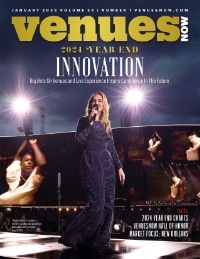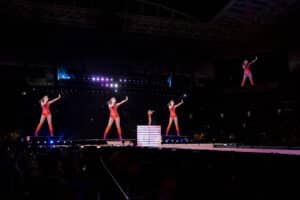GUNS UP: Texas Tech football players kneel in front of the new south end zone expansion at AT&T Jones Stadium, part of a $242 million renovation completed for the 2024 season. Premium seats now account for 12% of the stadium’s total inventory, Texas Tech Deputy AD/COO Jonathan Botros told VenuesNow Conference attendees. (Getty Images)
Mixed-use, special events, driving value on table
PHOENIX, Arizona — Jeff DeWitt encountered a bitterly cold day in February 2021 when he interviewed for the job of chief financial officer and vice chancellor for finance at the University of Kansas.
“It was six degrees above zero,” DeWitt recalled. “I had no idea why I went to (Lawrence) with that kind of weather, but I did. The chancellor (Douglas Girod) gave me a tour of the football stadium built during World War I. He said, ‘We need to replace it.’ I said, ‘Weren’t you 1-11 last year, how the heck could you possibly do that?’ He hired me anyway.”
DeWitt’s comments came during the closing panel at the 2024 VenuesNow Conference last week that encompassed athletic directors from San Diego State, Arizona State and Texas Tech, plus DeWitt and Brandon Comer, managing partner of Alterity Capital Group and his own firm, Comer Capital Group.
DeWitt is one example of the new breed of financial experts that universities are searching for to help them navigate the new world of college sports, where schools must find new revenue streams in the age of Name, Image and Likeness and revenue sharing with athletes, pending the outcome of a federal lawsuit over about $2.8 billion in unpaid fees.
At Kansas, the Big 12 school faced a $50 million structural deficit, resulting in a big challenge to come up with a nine-figure sum to build a new football stadium, according to DeWitt. As officials went through the process, they thought it made better sense to develop a multiuse facility over strictly a sports venue holding six to seven football games a year.
The result was adding a conference center attached to the stadium as part of the overall project, funded by the state providing $85 million to build the 55,000-square-foot building on the north side of the reconstructed venue. KU’s plan, in tandem with Oak View Group, which won the bid to run the stadium and conference center, is to book 200 events annually across the complex.
The school is in the process of completing a public-private partnership to build a new hotel, student housing, retail, medical center and parking. The cost is $350 million for the mixed-use components in addition to the $450 million stadium project. The first phase of stadium reconstruction, the west side, will be completed for the 2025 season.
All told, it’s the biggest economic development package Lawrence has ever seen, DeWitt said.
“You’re looking at a facility the entire city uses and that’s kind of a new concept in college athletics,” he said. “It will report to the chancellor’s office, as opposed to the athletic department, because it’s multiuse. You’ve (still) got to keep the football coach happy. Everything is getting shaken up. We’re all involved in it together at different stages, in different ways.”
In that respect, San Diego State is ahead of the game after opening Snapdragon Stadium, their 35,000-seat football venue that opened in 2022 with multiple tenants. The on-campus development extends to the future Mission Valley Innovation District spanning 1.6 million square feet, a hotel and conference center and up to 4,600 residential units.
All told, it’s a massive, $3.5 billion investment, to be shared between public interests and private developers, connected to a school that joins the Pac-12 Conference in 2026.
“We knew we would be the (only football) stadium in San Diego, so we wanted to make sure that we took advantage of that and build something that would work for all the different events that would come into a major city like San Diego,” John David Wicker , San Diego State Director of Athletics, said. “I wanted a stadium we could use 365 days a year. We have the benefit of great weather, so let’s build lots of standing room only, dynamic spaces, but make it something special.”
In addition, Snapdragon’s northeast corner was designed specifically to set up food trucks for all events in a space that can hold small concerts, an easy setup for up to 1,000 people.

ATHLETIC TYPES: OVG’s Peter Zingoni, from left, led the college sports panel discussion with San Diego State’s J.D. Wicker, Arizona State’s Graham Rossini, Texas Tech’s Jonathan Botros, financial expert Brandon Comer and Kansas’ Jeff DeWitt. (OVG Photo)
Apart from San Diego State football, sports events extend to the National Women’s Soccer League’s San Diego Wave, a tenant since 2022, and a Major League Soccer expansion team that starts play next spring.
To make all tenants happy, the school structured their agreements to avoid having to work around exclusive sponsorships in the stadium outside of Snapdragon, the naming rights holder and a tech subsidiary of Qualcomm.
“We have the Toyota Terrace, but if the MLS team wants to come in and put Nissan on the front of their jersey, they can do that,” Wicker said. “Did I leave some money on the table? Absolutely, but we’re making that up, because all our tenants can come in and be successful and they’re generating revenue for us.”
Texas Tech is slowly moving in an entrepreneurial direction for programming events at its football stadium, keeping in mind the school’s 15,000-seat on-campus arena, United Supermarkets Arena, run by longtime executive director Kent Meredith, has actively booked concerts since it opened 25 years ago in Lubbock.
Last year, Texas Tech hired hired Chase Jolesch as chief revenue officer, a new position in the athletic department. Jolesch previously spent more than 10 years selling premium seats and tickets in the NHL and NFL.
“We’re at the start of that shift,” said Jonathan Botros, Texas Tech’s deputy athletic director and chief operating officer. “As an administration, we’ve reserved our facilities to make sure they’re always available to our sports teams, because we want to make sure that we don’t lose any advantage there. We haven’t had a concert in our football stadium in 15 years, and we’re looking at hosting two to three shows next year. It’s a balance, and we’ll learn as we go.”
AT&T Jones Stadium recently completed a $242 million renovation, in part to help meet high demand for premium seats. Botros said the project increased the total number of suites to 102 with a waitlist of 150 that want to buy one, Botros said.
Overall, the percentage of premium seats has gone up from 7.5% to 12% of total inventory at the 60,000-seat facility. There’s a new tunnel club at field level, where fans can see the Red Raiders enter the field, a relatively new feature in the college space.
“Our new training facility opens next month and there’s all sorts of elements specifically geared around NIL, such as a podcast studio,” Botros said. “We’re going to have a barber shop in there. Every element of the renovation is looking at generating revenue and creating experiences for our fans and student-athletes.”
At Arizona State, the new member of the Big 12 Conference sits in a crowded Phoenix market saturated with multiple big-league facilities. On its own, ASU runs roughly 250 events over the course of 10 months across its sports venues, attracting between 2.5 and 3 million fans, said Athletic Director Graham Rossini. Those numbers don’t include concerts, graduations and political events taking place on campus, he said.
As a result, the school’s focus is on promoting value creation tied to commercial assets, for example, selling naming rights and founding partners for Mountain America Stadium, which was formerly Sun Devil Stadium before ASU sold naming rights to the regional credit union in 2023.
Rossini spent 13 years with MLB’s Arizona Diamondbacks before joining ASU’s athletic department in 2021. He served as senior associate athletic director and chief business officer before getting promoted to the athletic director’s position five months ago. The school has about 140,000 undergraduate students, among the biggest in the country.
“We’ve tried to shift our focus away from solely revenue generation to more of a long-term affinity play,” Rossini said. “It’s more about focusing on volume and everything that we’ve got going on over the course of the year. There’s a strong attribute to the quality of your partnerships and using your marketplace in a way that you’re not always going back to the same group of donors to help support it.”








